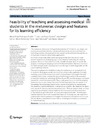Identificador persistente para citar o vincular este elemento:
https://accedacris.ulpgc.es/jspui/handle/10553/132036
| Título: | Feasibility of teaching and assessing medical students in the metaverse: design and features for its learning efficiency | Autores/as: | Rodríguez-Florido, Miguel Angel Reyes Cabrera, José Juan Melian, Aday Hernández-Flores, Carmen-Nieves Ruiz Alzola, Juan Maynar, Manuel |
Clasificación UNESCO: | 33 Ciencias tecnológicas | Palabras clave: | Medical Education Metaverse Immersive Virtual Reality |
Fecha de publicación: | 2024 | Publicación seriada: | Journal of New Approaches in Educational Research | Resumen: | The metaverse is known as the hypothetical iteration of the Internet as a single, connected, universal and immersive virtual world that can be accessed via immersive technology devices. One approach to this concept can be achieved through the use of multi-user immersive virtual reality applications.Immersive virtual reality (IVR), which uses gadgets that allow the user to visualize and interact in an enveloping way, is a very attractive technology for teaching purposes. There are many references in the scientific literature about its use for this purpose, including encouraging results in the field of medicine. However, there have not been enough studies assessing how much this type of technology really contributes to learning medicine.This work investigates the feasibility of using the metaverse as an educational tool in medicine. We propose a multi-user immersive virtual reality application for implementing a scene of the metaverse in which medical students are taught. Our work considers that in order to ensure this type of technology is useful in the education of medical students, the technology itself (multi-user IVR) must be designed and implemented for a medical student profile. They usually spend too much time for adapting themselves to use and manage this kind of technology when they are exposed to it for learning. The technology should not be a barrier to acquiring, or disseminating the academic contents themselves. It should act as a catalyst that enhances the speed and capacity for learning medical educational topics. Thus, we present design and user experience specifications that we implemented in an anatomical dissection room in the metaverse, and with which we conducted experiments with 114 sixth-grade medical students. Our results indicate that, based on the design and user experience characteristics that we propose in this paper, the metaverse can indeed serve as a useful and effective educational resource whose technological complexity is no barrier to medical teaching. | URI: | https://accedacris.ulpgc.es/handle/10553/132036 | ISSN: | 2254-7339 | DOI: | 10.1007/s44322-024-00009-6 | Fuente: | Journal Of New Approaches In Educational Research[ISSN 2254-7339],v. 13 (1), (Mayo 2024) |
| Colección: | Artículos |
Citas SCOPUSTM
3
actualizado el 08-jun-2025
Citas de WEB OF SCIENCETM
Citations
2
actualizado el 08-jun-2025
Visitas
1
actualizado el 10-ene-2026
Google ScholarTM
Verifica
Altmetric
Comparte
Exporta metadatos
Los elementos en ULPGC accedaCRIS están protegidos por derechos de autor con todos los derechos reservados, a menos que se indique lo contrario.
